Unlike many corporate areas in the virtual world, the NBA Headquarters incorporates capabilities designed to keep fans coming back, including real-time 3-D diagrams of games as they're played.
The NBA on Tuesday plans to launch NBA Headquarters, a Second Life area with games, interactivity, and community features designed to provide basketball fans with a place to get together and get involved.
NBA's area can potentially bring Second Life basketball fans back for repeat business. That's a contrast to many of the other corporate areas in Second Life, which are sterile places where visitors might come once, but never return. NBA Headquarters, by contrast, has multiplayer games and a variety of other features designed to draw repeat visitors.
The professional basketball organization is trying to recruit fans who are already in Second Life, as well as generate new fans, NBA commissioner David Stern said. NBA Headquarters in Second Life is part of the NBA's strategic drive to embrace new media, including Yahoo, Facebook, wireless communications, and online video including YouTube.
"This is an area we find to be very exciting," Stern said. "It's causing us to rethink overall the concept of how our fans consume NBA content." Stern spoke at a live announcement in two media: Second Life, and a conference call.
NBA recruited The Electric Sheep Co., a virtual worlds consultancy, to help build NBA Headquarters. Electric Sheep looks to help real-world businesses set up areas in Second Life and other virtual worlds. It occupies a position in the virtual world economy similar to the position occupied by Web marketing companies in the first years of the Web.
The simulation has the potential to capitalize on one of the strengths of Second Life. The virtual world is really a social medium, where people from all over the world come together for chat and activities in real-time, using a 3-D interface. Popular activities in Second Life today include listening to live and recorded music and participating in discussion groups. It's a natural step for people to gather in Second Life to watch a real-time diagram of a basketball game in progress, while chatting with each other about the play and watching the game on TV in their separate, real-life living rooms.
NBA Headquarters includes a virtual basketball court, where avatars can sit and watch a real-time, 3-D diagram of NBA games:
And a shop where you can buy NBA-logo virtual merchandise for your avatar. The front of the shop is a reproduction of one in Manhattan:
One feature that will appeal to Second Life users -- the chairs in the basketball arena are "scripted." Once a user sits his avatar in the chair, the user can flick his point of view from the playing field (with its real-time diagram) to the scoreboard, and back again. That's a convenience; in most places in Second Life, the user has to manually change his camera point of view by combinations of keystrokes and mouse movements. The NBA area also features a downloadable toolbar (in Second Life jargon, those are called HUDs, for "heads-up displays") to provide a realtime feed of NBA news and control a couple of in-world games, which allow avatars to play basketball against each other. The games include the playground basketball game H.O.R.S.E., where players take turns shooting baskets, as well as another in which avatars attempt to dunk the ball.
The area also includes four video lounges where fans can watch past playoffs and highlights of past games.
And users can get their pictures taken with the championship trophy. That's my avatar, Ziggy Figaro:
When posing with the trophy, the point-of-view automatically moves into position, and the user has a choice of several goofy poses.
During the press conference, Stern said the NBA was attracted to Second Life in part because of its massive user base, which Stern said was 6 million users. Actually, that's not quite true. As of Monday at 3 p.m. Pacific time, Second Life was indeed on the verge of rolling the odometer over to 6 million accounts created since the virtual world open for business four years ago -- 5,968,396 accounts, to be precise.
However, the number of actual users of Second Life is much smaller. Linden Lab itself estimates the user retention rate at about 10% -- which would be almost 600,000 active accounts. And dedicated users will often create more than one account (the secondary accounts, in Second Life jargon, are called "alts.")
Still, Second Life does have an impressive growth rate, 20% per month, and 40% of the users are women, Stern noted. Second Life will be part of the NBA's effort to diversify its fan base, which also includes programs to recruit Hispanics and women as fans.
The NBA and Electric Sheep declined to comment on financial details for the area, except to say that it is supported by advertising from partners including T-Mobile, Toyota, and Cisco Systems. Different parts of NBA Headquarters bear prominent corporate sponsorship, for example: The T-Mobile Arena and T-Mobile Half Court Shot Contest.
The area is free to all Second Life users.
The NBA is selling merchandise at its store. Pricing is competitive with other virtual merchandise sold in Second Life. For example, a team logo jersey, that users can put on their avatars, is priced at 100 Linden Dollars, competitive with other virtual clothing for avatars. The Linden Dollar is Second Life's in-world currency for micropayments, priced at about 260 L$ per U.S. dollar.
The NBA has an advantage in marketing its site -- it has the vast marketing machine of NBA behind it. The Second Life area will be marketed on the organization Web site, television, blogs, wireless, and broadband channels.
NBA fans will be able to join Second Life through the NBA Web site.. Once that's done, the fans will bypass the general Second Life orientation area, and instead go to one operated by the NBA, where the fans will go through a self-teaching program to learn how to move in Second Life, look around, and interact with other people. NBA is providing the customized logins through a set of APIs that Linden Lab -- the company that created, develops and operates Second Life -- makes available to any company. The cable TV channel Showtime has a similar setup for its show, The L Word.
The NBA area occupies four separate "sims," or software servers, at the data center of Linden Lab, said Michael Morton, a producer at Electric Sheep, who functions as a project manager for the company.
Electric Sheep built the software using the building tools that come standard with the client software that every user uses to access Second Life. They also used Adobe Photoshop for importing images into the game.
Some of the features of the area -- including the online trivia game -- required access to software running on Web servers, which was accessed by Second Life using the Web's standard HTTP and secure HTTPS protocols.
I loved the detail in the press-room build: The tables draped in cloth, the backdrop hung from a bare metal pole, the bare wooden floor in front of the tables, the uncomfortable folding chairs. I've been at about a million press conferences like this in real life. That's me in the hat in the front row, below:
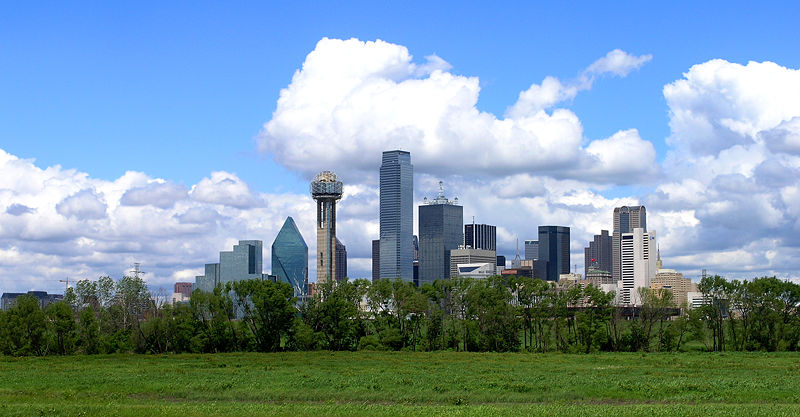
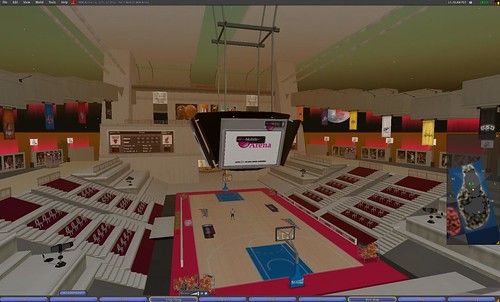

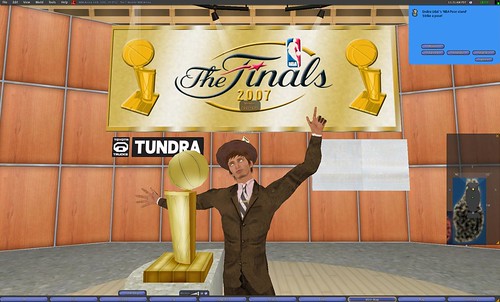
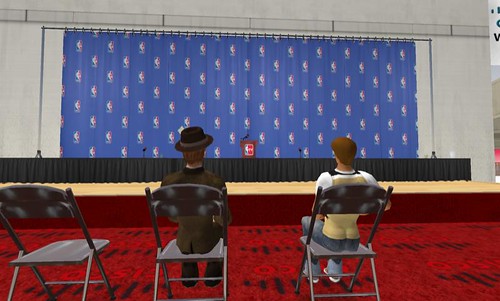
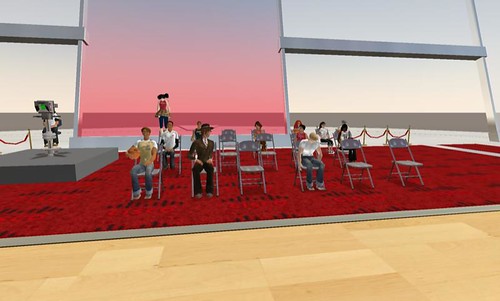
No comments:
Post a Comment